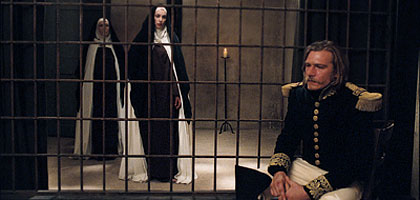Primary navigation

France/Italy 2006

Reviewed by Jonathan Romney
Our synopses give away the plot in full, including surprise twists.
Mallorca, 1823. French general Armand de Montriveau discovers his lost love, the Duchess Antoinette de Langeais, living in a rigorous Carmelite convent, having taken the veil as Sister Thérèse.
Paris, five years earlier: newly returned from Africa, Armand fascinates the married Antoinette at a soirée. He begins to visit her at home and falls in love with her, but Antoinette's coquettish command of social manners keeps her in control of their relationship. Despite their intimacy, Antoinette refuses to yield to Armand entirely. Vowing revenge, he has Antoinette abducted from a ball and threatens to brand her on the forehead; Antoinette realises how much she loves Armand, but too late. For months Armand refuses to see her, and she compromises herself socially by advertising her devotion to him. Antoinette writes to Armand to plead for one more chance but, detained by a pair of friends and a stopped clock, he misses their rendezvous.
Five years later, Armand mounts a daring attempt to kidnap Sister Thérèse from the convent, only to find that she has died.
Jacques Rivette's Don't Touch the Axe is a surprisingly faithful adaptation of Balzac's 1834 novel La Duchesse de Langeais, the central part of his trilogy L'Histoire des Treize - the conspiracy motif of which provided the underpinning of Rivette's vast experimental drama Out 1 (1971). While there is a huge imaginative and formal gulf between Out 1's free-associative sprawl and the introverted formal rigour of Don't Touch the Axe, the new film's ostensible realism offers uncanny echoes of other earlier Rivette films: the clifftop setting of the framing narrative, especially the cloak-and-dagger finale, recalls the stormily fanciful pirate yarn Noroît (1976), while the church at the start, with its curtains and prison-like bars, inescapably recalls the claustration of Diderot adaptation La Religieuse (1965).
Such echoes, at work in an ostensibly straightforward Balzac adaptation, signal familiar Rivette themes of enclosure and escape - an opposition apparent in a story of barely containable desire within a cage of stiffly formalised social codes. Characterised as a sort of Napoleonic wild beast ill at ease in the tameness of Restoration Paris, Armand - a general newly returned from Africa who initially fascinates married duchess Antoinette with stories of his exploits - is associated from the start with the great outdoors, prowling Mallorca's windlashed ramparts, while Antoinette is first seen doubly imprisoned, in nun's cowl and behind a grille.
In the film's central Paris-set section, Antoinette proves entirely in command of her territory, the world of the aristocratic Faubourg Saint-Germain. The film is largely set in a series of enclosed salon and boudoir interiors, an overtly theatrical domain in which Antoinette is a surpassing mistress of mise en scène. Preparing for Armand's first visit, she arranges herself for maximum effect on a canapé, in discreet déshabille, ordering her servant to lower the lighting (the thematics of light and heat later extended in the fireplace that Armand pokes with barely contained sexual frustration, and in the brand with which he threatens Antoinette).
As actress, Antoinette is skilled at the well-timed entrance and exit, whereas Armand habitually arrives too early, or storms inopportunely into the star's dressing room. It is part of Armand's revenge that he at last masters both mise en scène and performance, in a startlingly excessive scene that replaces Antoinette's poised comedy of manners with a lurid melodrama: in it, he plays a menacing Byronic ravisher, supported by masked men hovering around a brazier. This sudden eruption of violence in the middle of an analytical drama may seem wildly incongruous, yet the tonal discontinuity comes directly from Balzac's story, and Rivette achieves the seemingly impossible in making such a disjunction work convincingly on screen. The violence at the heart of the story, together with its cautionary-tale aspect, is foregrounded by Rivette's reversion to Balzac's original title for his novel. The reference is to a veiled warning that Armand gives Antoinette, the axe being the English one that beheaded Charles I - the implication is that the reckless cause their own downfall. In reality, however, Armand himself figuratively wields the axe that will destroy his own chance of happiness.
The drama portrays love as a war of attrition, with Antoinette conducting a campaign of resistance that passes through social-political and religious phases before apparently yielding to at least some of Armand's demands. That they have become physically as well as emotionally intimate is suggested by their referring to each other as 'husband' and 'wife' - although, rather than devotion, this suggests both jealous possession and the onset of outright conjugal hostilities. Literal sexual relations are no more immediately the issue here than in the conventionally indirect terms of Balzac's novel. The absolute possession Armand craves is at once physical, social and transcendental, a total marriage of bodies and souls that in the end is at once consummated and sublimated in his threatened symbolic violation of Antoinette.
Elegantly staged and meticulously paced, right down to the suspensefully extended penultimate act in which Armand is detained by two facetiously garrulous friends, Don't Touch the Axe, for all its austerity, offers a more satisfying and direct emotional reward than many of Rivette's films. It also offers a peerless display of contemporary French screen acting, not least in the cameos by long-term Rivette regular Bulle Ogier, as a doyenne who instructs Antoinette in the art of amorous politics, and Michel Piccoli, whose bumbling but stately affability as the elderly Vidame de Pamiers loosens up the overall formality. Guillaume Depardieu is an imposingly blustery and introspective Armand, the actor's real-life prosthetic leg adding a heavy dramatic momentum to the soldier's stiff, heavy gait, while Jeanne Balibar works Antoinette's mercurial charisma to the hilt. A former Comédie Française repertory player, who played a stage actress in Rivette's Va savoir, Balibar uses her sometimes mannered knowingness to magnificent effect, making the coquettish Antoinette a true star of the salons, mapping her progress from mistress of light social comedy to full-blown tragic heroine.